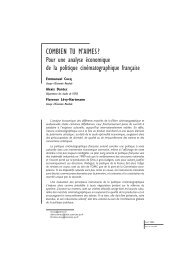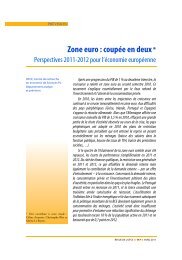direct multi-step estimation and forecasting - OFCE - Sciences Po
direct multi-step estimation and forecasting - OFCE - Sciences Po
direct multi-step estimation and forecasting - OFCE - Sciences Po
Create successful ePaper yourself
Turn your PDF publications into a flip-book with our unique Google optimized e-Paper software.
Direct <strong>multi</strong>-<strong>step</strong> <strong>estimation</strong> <strong>and</strong> <strong>forecasting</strong><br />
9 Direct Multi-<strong>step</strong> <strong>estimation</strong> <strong>and</strong> <strong>forecasting</strong><br />
9.1 Design of forecast estimators<br />
In this section, we provide a general definition for the two types of forecasts which we have studied so<br />
far, namely the iterated one-<strong>step</strong> ahead (IMS h ) <strong>and</strong> <strong>direct</strong> h-<strong>step</strong> (DMS h ). We borrow a framework<br />
for the design of forecast estimators from Ericsson <strong>and</strong> Marquez (1998) <strong>and</strong> extend it to allow for<br />
dynamic <strong>estimation</strong>. Here, the modeler is interested in n endogenous variables, x, <strong>and</strong> assumes<br />
that they depend on their lagged values, up to some p ≥ 0, on some weakly exogeneous—which<br />
they actually may or may not be—variables z <strong>and</strong> on some vector of c parameters ϕ. The model<br />
specifies some error process {ɛ t } —the distribution thereof may depend on ϕ <strong>and</strong> exhibit any<br />
form of autocorrelation, heteroscedasticity or non-stationarity—<strong>and</strong> is assumed to be valid over a<br />
sample of size T + H, so that there exists a n-vector function f (·), such that:<br />
f (x t , ..., x t−p , z t , ϕ, ɛ t ) = 0, for t = p, ..., T, ..., T + H. (20)<br />
The sample is split into two: <strong>estimation</strong> is conducted over the first T observations <strong>and</strong> this is<br />
used to forecast the remaining H. Equation (20) describes an open model <strong>and</strong> it is convenient to<br />
transform it in a reduced closed form, solving it for x t . We change the time subscript t to T + i,<br />
<strong>and</strong> assume—under mild conditions, amongst which linearity of f (·) is most common—that there<br />
exists a suitable transform of f(·), denoted by g(·), such that positive values of i represent the<br />
dates for which we wish to obtain forecasts in:<br />
x T +i = g (x T +i−1 , ..., x T +i−p , z T +i , ϕ, ɛ T +i ) , for i = p − T, ..., −1, 0, 1, ..., H. (21)<br />
Notice that this framework—as delineated in (21)—is quite general, <strong>and</strong> it may be the case that<br />
specific models should be restrictions thereof.<br />
For instance, if n = 1, g (·) reduces to a single<br />
equation; it may also be nonlinear <strong>and</strong> the model could be static—if p = 0—or exclude exogenous<br />
variables.<br />
For <strong>forecasting</strong> at horizons i > 1, there is a need for assumptions about the vector z t : either it<br />
is assumed strongly exogenous <strong>and</strong> it is possible to obtain conditional forecasts (see Engle, Hendry,<br />
<strong>and</strong> Richard, 1983), or a model for its behaviour is used, <strong>and</strong> in fact z is incorporated in x. The<br />
forecasts are defined by their horizon, i, the actual variable of interest—which can be a transform of<br />
34








